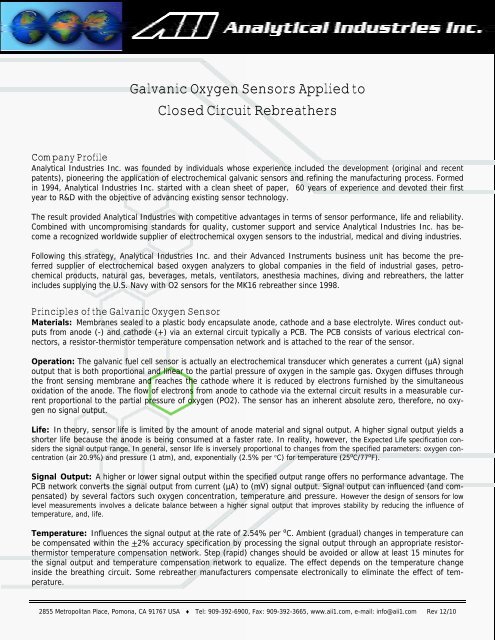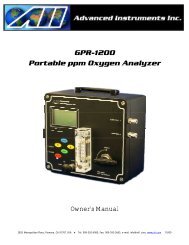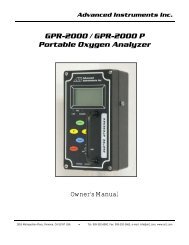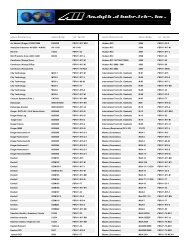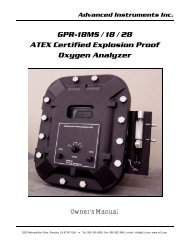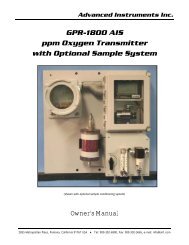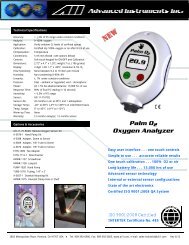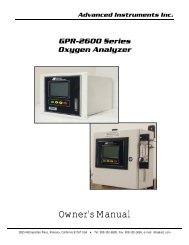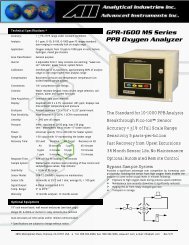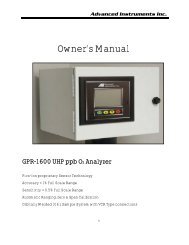Galvanic Oxygen Sensors Applied to Closed Circuit Rebreathers
Galvanic Oxygen Sensors Applied to Closed Circuit Rebreathers
Galvanic Oxygen Sensors Applied to Closed Circuit Rebreathers
Create successful ePaper yourself
Turn your PDF publications into a flip-book with our unique Google optimized e-Paper software.
<strong>Galvanic</strong> <strong>Oxygen</strong> <strong>Sensors</strong> <strong>Applied</strong> <strong>to</strong><strong>Closed</strong> <strong>Circuit</strong> <strong>Rebreathers</strong>Company ProfileAnalytical Industries Inc. was founded by individuals whose experience included the development (original and recentpatents), pioneering the application of electrochemical galvanic sensors and refining the manufacturing process. Formedin 1994, Analytical Industries Inc. started with a clean sheet of paper, 60 years of experience and devoted their firstyear <strong>to</strong> R&D with the objective of advancing existing sensor technology.The result provided Analytical Industries with competitive advantages in terms of sensor performance, life and reliability.Combined with uncompromising standards for quality, cus<strong>to</strong>mer support and service Analytical Industries Inc. has becomea recognized worldwide supplier of electrochemical oxygen sensors <strong>to</strong> the industrial, medical and diving industries.Following this strategy, Analytical Industries Inc. and their Advanced Instruments business unit has become the preferredsupplier of electrochemical based oxygen analyzers <strong>to</strong> global companies in the field of industrial gases, petrochemicalproducts, natural gas, beverages, metals, ventila<strong>to</strong>rs, anesthesia machines, diving and rebreathers, the latterincludes supplying the U.S. Navy with O2 sensors for the MK16 rebreather since 1998.Principles of the <strong>Galvanic</strong> <strong>Oxygen</strong> SensorMaterials: Membranes sealed <strong>to</strong> a plastic body encapsulate anode, cathode and a base electrolyte. Wires conduct outputsfrom anode (-) and cathode (+) via an external circuit typically a PCB. The PCB consists of various electrical connec<strong>to</strong>rs,a resis<strong>to</strong>r-thermis<strong>to</strong>r temperature compensation network and is attached <strong>to</strong> the rear of the sensor.Operation: The galvanic fuel cell sensor is actually an electrochemical transducer which generates a current (µA) signaloutput that is both proportional and linear <strong>to</strong> the partial pressure of oxygen in the sample gas. <strong>Oxygen</strong> diffuses throughthe front sensing membrane and reaches the cathode where it is reduced by electrons furnished by the simultaneousoxidation of the anode. The flow of electrons from anode <strong>to</strong> cathode via the external circuit results in a measurable currentproportional <strong>to</strong> the partial pressure of oxygen (PO2). The sensor has an inherent absolute zero, therefore, no oxygenno signal output.Life: In theory, sensor life is limited by the amount of anode material and signal output. A higher signal output yields ashorter life because the anode is being consumed at a faster rate. In reality, however, the Expected Life specification considersthe signal output range. In general, sensor life is inversely proportional <strong>to</strong> changes from the specified parameters: oxygen concentration(air 20.9%) and pressure (1 atm), and, exponentially (2.5% per °C) for temperature (25⁰C/77⁰F).Signal Output: A higher or lower signal output within the specified output range offers no performance advantage. ThePCB network converts the signal output from current (µA) <strong>to</strong> (mV) signal output. Signal output can influenced (and compensated)by several fac<strong>to</strong>rs such oxygen concentration, temperature and pressure. However the design of sensors for lowlevel measurements involves a delicate balance between a higher signal output that improves stability by reducing the influence oftemperature, and, life.Temperature: Influences the signal output at the rate of 2.54% per ⁰C. Ambient (gradual) changes in temperature canbe compensated within the +2% accuracy specification by processing the signal output through an appropriate resis<strong>to</strong>rthermis<strong>to</strong>rtemperature compensation network. Step (rapid) changes should be avoided or allow at least 15 minutes forthe signal output and temperature compensation network <strong>to</strong> equalize. The effect depends on the temperature changeinside the breathing circuit. Some rebreather manufacturers compensate electronically <strong>to</strong> eliminate the effect of temperature.2855 Metropolitan Place, Pomona, CA 91767 USA ♦ Tel: 909-392-6900, Fax: 909-392-3665, www.aii1.com, e-mail: info@aii1.com Rev 12/10
Pressure: Influences signal output on a proportional basis. Tests show sensors are accurate at any constant pressureup <strong>to</strong> 30 atm provided the sensor is pressurized equally front and rear. A pressurized sensor must decompressed gradually(similar <strong>to</strong> a human).Altitude: Dives of 200 ft. produce an error of 0.3% and do not have a significant effect on the signal output.Humidity: Water vapor according <strong>to</strong> Dal<strong>to</strong>n’s Law of Partial Pressure exerts its own partial pressure when added <strong>to</strong> agas stream, thereby, reducing the partial pressure of oxygen and the reading displayed. Conversion charts are availablefor air calibration which define the effect of humidity on the oxygen level.Carbon Dioxide (CO2): An acid gas that reacts with the sensor’s base electrolyte. The effect on the sensor varies withexposure time. Exposure <strong>to</strong> CO2 for 15-20 minutes followed by flushing with air has virtually no effect on the sensor.Repeated exposure of 3-4 hours can result in a temporary loss of signal output. Continuous exposure has a dramaticeffect on sensor life. For example a sensor with a normal 12 month life in air at 77⁰ and 1 atm that is continuously exposed<strong>to</strong> 5-6% CO2 will expire in 3-4 weeks.Load: The sensor does not <strong>to</strong>lerate reverse current flowing in<strong>to</strong> the sensor. No load is recommended, but 10K Ohm isthe maximum permissible. Exceeding a load of 10K Ohm produces an error in linearity.Calibration: Follow the recommendations included in the rebreather manufacturer’s Owner’s Manual. Perform at ornear operating conditions, e.g. if measuring dry compressed gas, calibrate with same or if calibrating in air use a conversionchart which defines the effect the humidity (above) and temperature on the oxygen level. Do not calibrate with airwhen intending <strong>to</strong> measure above 30% oxygen, calibrate with 100% oxygen.Mode of Failure: Defect or MisusePreface: His<strong>to</strong>rically, when a sensor does not function beyond its warranty period the issue of what is a defect as opposed<strong>to</strong> misuse arises. The intent here is <strong>to</strong> explore the effects and possible causes objectively.Normal Operation: When operated at or near the specified parameters (see sections of Signal Output and Life) signaloutput and anode consumption remain constant over 80-90% of the sensor’s expected life. As the signal output decreasesit falls below the lower limit of the electronic design and eventually preventing calibration of the electronics.S<strong>to</strong>rage: Prolonged exposure above 50⁰C (122⁰F) can weaken the seals that secure the front and rear membranes <strong>to</strong>the sensor and acerbate sub-microscopic pin holes (that escape a stringent leak test that every sensor passes) in thelaminated front sensing membrane both of which may result in electrolyte leakage in the shipping bag. Each degreeabove the specified parameter of 25⁰C (77⁰F) reduces expected sensor life by increasing the internal rate of reactionwhich accelerates the consumption of the anode.Shock: Can compromise electrical connections, break wires or cause a tear in the sensing membrane resulting in erraticreadings. Dropping a sensor from 3 ft. on<strong>to</strong> a carpeted concrete office slab (a) reduced signal output by at least 25% orworse (b) dislodged the anode contacted a cathode wire thus creating a short circuit.Erratic <strong>Oxygen</strong> Readings: Can result from a) shock; b) an aged sensor or well used sensor that is 2-3 years from itsmanufacture date (see Serialization/Date Code); c) blocking the “breather holes” in the PCB at the rear of the sensorprevents the pressure surrounding the sensor (front and rear) from equalizing; d) a load in excess of 10K Ohm; e) repeatedexposure <strong>to</strong> CO2 of 3-4 hours can result in a temporary loss of signal output, see Carbon Dioxide CO2.Higher than Expected <strong>Oxygen</strong> Readings: Result when minute pinholes (see S<strong>to</strong>rage) or tears in the sensing membraneallow additional unwanted oxygen <strong>to</strong> enter the sensor. The most common causes are the shock of dropping a sensoror pressing on the sensing surface in an attempt <strong>to</strong> remove liquid. Exposure <strong>to</strong> CO2 can also cause a temporary increasein the oxygen reading.2855 Metropolitan Place, Pomona, CA 91767 USA ♦ Tel: 909-392-6900, Fax: 909-392-3665, www.aii1.com, e-mail: info@aii1.com Rev 12/10
Liquid/Moisture: Condensation on the sensing surface of the sensor reduces the signal output by blocking the diffusion of oxygenin<strong>to</strong> the sensor and is mistakenly categorized as a sensor defect. The reality, there is no damage <strong>to</strong> the sensor, simply remove theliquid and the signal output returns.Complete Coverage: Signal output decreases 12mV <strong>to</strong> 10mV(17%) after 20 minutes.Partial Coverage: Signal output, no change.Orientation isimportantQuality Control of ManufacturingDesign: After years of experience working with and studying competitive galvanic oxygen sensors, Analytical Industrieshas focused on advancing the quality and reliability along with performance of their sensors by simplifying the assemblyprocess and eliminating sources of internal contamination. As a result, there are no welds, epoxy or dissimilar metalsinside the Analytical Industries sensor.Leak Test: A stringent proprietary test that detects microscopic pin holes in the laminated membranes and marginalmembrane seals. 100% of the base electrolyte sensors are subjected <strong>to</strong> this stringent procedure and must pass successfully,otherwise they are scrapped.Output Testing: Following leak test, all sensors sit for a predetermined period of time <strong>to</strong> allow the signal output <strong>to</strong> stabilize.Next, the current output (µA) of every sensor is tested and recorded.Diving sensors are then equipped with a PCB that includes the appropriate electrical connec<strong>to</strong>r and the temperaturecompensation network which converts the current (µA) signal output <strong>to</strong> (mV) output. Each sensor is tested 3x moretimes during the remainder of the assembly process before the sensor is accepted and serialized.Dive Pressure Test: Analytical Industries tests all diving sensors for output in air (20.9%) and linearity at 100% oxygen,and, under 1.6 ATA using a proprietary au<strong>to</strong>mated system developed in collaboration with rebreather manufacturersand instruc<strong>to</strong>rs. As illustrated, individual test reports aregenerated for and a copy shipped with every sensor. Theprint out documents the following:chamber pressure (ATA),fractional oxygen in the mix (FO2),partial pressure O2 dosage (PO2),the sensor’s signal output (mV) as the preceding parameterschange, and, whether that output (Result) was within
Quality Assurance ProgramQuality is taken very seriously. Mandated for medical devices, industrial and divingproducts comply with the same quality standards. The quality assuranceprogram is independently certified annually by and conforms <strong>to</strong>: ISO 9001:2008, U.S. FDA: 510(k) No. K952736, Europe: Annex II of Medical Device Directive 93/42/EEC as amendedby 2007/43/EEC, Canada: ISO 13485:2003Our approach <strong>to</strong> cus<strong>to</strong>mer service is proactive one, every product returned from the field requires a formal written assessmentreport a copy of which is sent <strong>to</strong> the cus<strong>to</strong>mer. We routinely contact cus<strong>to</strong>mers <strong>to</strong> discuss and educate, and inmany cases ourselves as well.His<strong>to</strong>rically, less than 1% of the sensors shipped are returned <strong>to</strong> Analytical Industries Inc. for warranty claims, and, ofthat figure less than one-half are determined <strong>to</strong> have manufacturing defects. Assessing these returns along with internalmanufacturing yields has enabled Analytical Industries Inc. <strong>to</strong> continually improve our products and secure additionalbusiness.Serialization / Date Code<strong>Oxygen</strong> sensors have a finite life. Understanding the date code embodied in the serial number is critical <strong>to</strong> determiningthe age or manufacture date of a sensor, maximizing the benefit of the warranty period. The serial number 90734789breaks down as follows:Digit #1: 9 identifies the year of manufacture as 2009Digits #2,3: 07 identifies the month of manufacture as JulyRemaining: Sequentially issued for uniquenessTo avoid diving with aged sensors, labeling of all rebreather sensors includes a SELL BY date (4 months) and DO NOTUSE AFTER date (16 months) from the month and year of manufacture specified or July 2009 in the above example.Warranty PolicyCoverage: Under normal operating conditions, the sensors are warranted <strong>to</strong> be free of defects in materials and workmanshipfor the period specified in the current published specifications.Analytical Industries in their sole discretion shall determine the nature of the defect. If the item is determined <strong>to</strong> be eligiblefor warranty we will repair it or, at our option, replace it at no charge <strong>to</strong> you. This is the only warranty we will giveand it sets forth all our responsibilities, there are no other express or implied warranties. The warranty period beginswith the date of shipment from Analytical Industries Inc. This warranty is limited <strong>to</strong> the first cus<strong>to</strong>mer who submits aclaim for a given serial number. Under no circumstances will the warranty extend <strong>to</strong> more than one cus<strong>to</strong>mer or beyondthe warranty period.For info call 909-392-6900, fax 909-392-3665 or e-mail diveaii@aii1.com. To make a warranty claim, you must returnthe item and postage prepaid <strong>to</strong>: Analytical Industries Inc., 2855 Metropolitan Place, Pomona, Ca 91767 USAExclusions: This warranty does not cover normal wear and tear; corrosion; damage while in transit; damage resultingfrom misuse or abuse; lack of proper maintenance; unauthorized repair or modification of the analyzer; fire; flood; explosionor other failure <strong>to</strong> follow the Owner’s Manual.Limitations: Analytical Industries Inc. shall not liable for losses or damages of any kind; loss of use of the analyzer;incidental or consequential losses or damages; damages resulting from alterations, misuse, abuse, lack of proper maintenance;unauthorized repair or modification of the analyzer.2855 Metropolitan Place, Pomona, CA 91767 USA ♦ Tel: 909-392-6900, Fax: 909-392-3665, www.aii1.com, e-mail: info@aii1.com Rev 12/10
What We Have Learned . . .The effects of the <strong>to</strong>pics listed below are discussed in detail in the preceding pages and in the interest of brevity are notduplicated.Challenging Application: When it comes <strong>to</strong> the closed circuit rebreather the oxygen sensor is exposed <strong>to</strong> an environmentthat plays <strong>to</strong> more of the device’s weaknesses than its strengths. That is not <strong>to</strong> say the oxygen sensor is not suitedfor this application, but getting the most out of the oxygen sensor requires working around the limitations, understandingthe device and a little discipline in terms of handling and maintenance.Preventive Maintenance: Our investigation has yielded a surprising number of cases involving diving with old sensors,the lack of regular sensor replacement and failure <strong>to</strong> follow the rebreather manufacturer’s calibration procedure.Design: Currently there are no regulations governing rebreather manufacturers which accounts for the various designson the market.Temperature: The CO2 scrubber generates heat which keeps the temperature inside the rig around 90⁰F. The designshould locate the oxygen sensor in the coolest location possible.Liquid: The heat generated by the CO2 scrubber also produces a continual source of condensation which does notdamage the sensor itself. Again the design should position the oxygen sensors <strong>to</strong> minimize or prevent the collection ofwater on the sensing surface.Electronics: The quality of the computer systems used <strong>to</strong> control <strong>to</strong>day’s rebreathers vary from rig <strong>to</strong> rig. If the electronicsare flooded or malfunction a charge can be sent <strong>to</strong> the oxygen sensor resulting in permanent damage <strong>to</strong> the sensor,see Load. Electrical connec<strong>to</strong>rs should gold and kept watertight. However, using rubber-type caps <strong>to</strong> seal the connectionsat the back of the sensor can cause an unwanted pressure differential between the front and back of the sensor.Recommended Maintenance: Rebreather Owner’s Manuals repeatedly warn users <strong>to</strong> follow recommended maintenanceprocedures for post dive of opening and flushing the rig, proper inspection and lubrication of o-rings and seals <strong>to</strong>prevent leaks which could expose the oxygen sensors <strong>to</strong> oxygen levels of 70-100% and exposure <strong>to</strong> CO2.Shock: Even contribu<strong>to</strong>rs <strong>to</strong> the internet forums admit the rigs (and the components inside) are not accorded theproper handling, an issue for electronics as well as the oxygen sensor.2855 Metropolitan Place, Pomona, CA 91767 USA ♦ Tel: 909-392-6900, Fax: 909-392-3665, www.aii1.com, e-mail: info@aii1.com Rev 12/10


